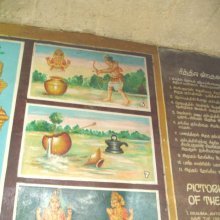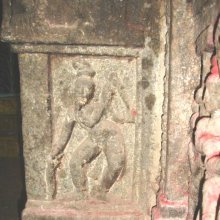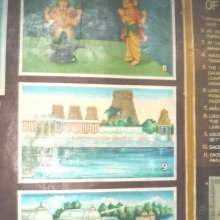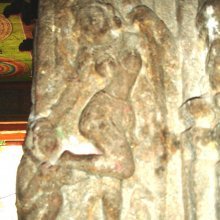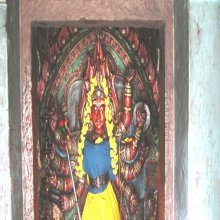Kiratamurti, Kirātamūrti, Kirata-murti: 2 definitions
Introduction:
Kiratamurti means something in Hinduism, Sanskrit. If you want to know the exact meaning, history, etymology or English translation of this term then check out the descriptions on this page. Add your comment or reference to a book if you want to contribute to this summary article.
Images (photo gallery)
In Hinduism
Shilpashastra (iconography)
Source: Shodhganga: Iconographical representations of Śiva (shilpa)Kirātamūrti (किरातमूर्ति) or simply Kirāta refers to one of the twenty-eighth forms (mūrti) of Śiva mentioned in the Vātulāgama: twenty-eighth among the Siddhāntaśaivāgama. The forms of Śiva (e.g., Kirāta-mūrti) are established through a process known as Sādākhya, described as a five-fold process of creation.
Source: Shodhganga: The significance of the mūla-beras (śilpa)Kirātamūrti is depicted in the Adi Kumbeswarar Temple (Ādi Kumbheśvara) in Kumbakonam (Kumbhakonam), representing a sacred place for the worship of Śiva.—Kirāta-mūrti is found in samapāda-sthānaka with four hands. The upper right hand holds cakra and the upper left hand holds śaṅkh in kartarīmukha hasta. The lower right hand holds the arrow in kaṭaka and the lower left hand holds the bow in kaṭaka.

Shilpashastra (शिल्पशास्त्र, śilpaśāstra) represents the ancient Indian science (shastra) of creative arts (shilpa) such as sculpture, iconography and painting. Closely related to Vastushastra (architecture), they often share the same literature.
See also (Relevant definitions)
Relevant text
Search found 2 books and stories containing Kiratamurti, Kirātamūrti, Kirata-murti, Kirāta-mūrti; (plurals include: Kiratamurtis, Kirātamūrtis, murtis, mūrtis). You can also click to the full overview containing English textual excerpts. Below are direct links for the most relevant articles:
Later Chola Temples (by S. R. Balasubrahmanyam)
Temples in Kumbakonam < [Chapter IV - Temples of Vikrama Chola’s Time]
Temples in Melaperumballam < [Chapter IV - Temples of Vikrama Chola’s Time]
Early Chola Temples (by S. R. Balasubrahmanyam)
Bronze, group 3: Age of Parantaka I (a.d. 907 - 950) < [Chapter XI - Sculpture]
Related products
